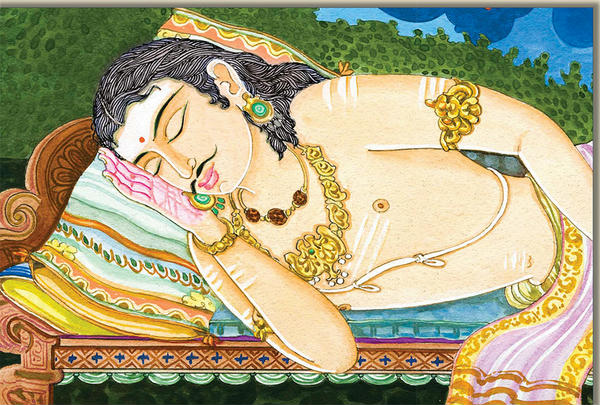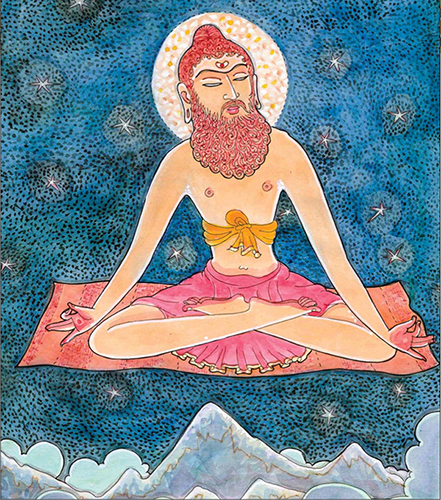What Are the Four States of Consciousness?
 ONSCIOUSNESS IS NOT A MERE METAPHYSICAL CONCERN OF little practical relevance to us. It is the source and ground of our every experience in life. India’s sages knew that each day for us is a journey through consciousness, and they spoke of four states (avastha chatushtaya): waking, dreaming, deep sleep (technically called Non-REM sleep), and a fourth state beyond. We are ordinarily concerned only with the waking state and its demands, but dream and deep sleep also have their value, identity and experiences. These two subtle states have a profound impact on us, from health to spirituality, and should not be ignored.§
ONSCIOUSNESS IS NOT A MERE METAPHYSICAL CONCERN OF little practical relevance to us. It is the source and ground of our every experience in life. India’s sages knew that each day for us is a journey through consciousness, and they spoke of four states (avastha chatushtaya): waking, dreaming, deep sleep (technically called Non-REM sleep), and a fourth state beyond. We are ordinarily concerned only with the waking state and its demands, but dream and deep sleep also have their value, identity and experiences. These two subtle states have a profound impact on us, from health to spirituality, and should not be ignored.§
1. The Waking State, Jagrat Avastha§
We do not dwell in a uniform state of consciousness throughout the day. The nature of our consciousness changes radically through the states of waking, dream and deep sleep. The waking state shows us a vivid outer world through the five senses. It appears steady and solid and can be experienced objectively by each of us. Yet, our waking experience has many variations relative to our thoughts, emotions and attention span, from moments of clarity to periods of distraction and dullness. Additionally, physical reality, by nature, has many fluctuations, uncertainties and is ultimately transient.§
2. Dreaming, Svapna Avastha§
The dream state provides an inner, imaginative consciousness that is dramatic and colorful, changes rapidly and is subjective in nature. In dreams we create our own personal reality, with its own sense of time and space, but with seemingly little lasting effect on our outer lives. Ordinarily we take the dream world to be unreal, as compared to the reality we give to the waking world. Yet, dreams and astral experiences have their own beauty and fascination.§
Most of us look upon the dream state as simply a condition in which our memories and subconscious patterns reverberate and express themselves. Often these patterns are meaningless, but we do at times have meaningful dreams. Sometimes we have inspiring dreams that enrich our waking life. Or we may have disturbed dreams that make us fear the dream state. Examining the dream state, psychoanalysis finds only reflections of the urges and traumas of the waking state. Its explorations are limited to the subconscious and unconscious states of awareness, with little understanding of the deeper layers of consciousness that lie beyond.§
Overall, we often live in fantasy, which means dreaming even in the waking state. We find our waking state proceeds too slowly and does not give us the type of wish fulfillment that we seek. This makes exploring the realms of imagination and dream a fascinating pastime. Today technology is providing us with “virtual reality” and “augmented reality,” which are much like dream projections in the waking state. Soon people may prefer this virtual reality, which is somewhere between waking and sleep, as it can better fulfill our dreams and wishes but with a stronger connection to physical reality than the dream state. Such miracles of technology are now bordering on the occult.§
Yoga teaches that there is an entire dream world and we have a dream self with its own existence and identity. This is our astral body, in which our soul resides after our death experience. While we also abide in the astral body all the time, most people are aware in it only superficially, though some souls enjoy a strong astral experience throughout life. Many such inwardly aware beings become artists, mystics, occultists and psychics.§
While in the waking state, we work with an objective world born of collective karma. In the dream state, we work with a subjective world born of our own thoughts and imaginations. This poses a dilemma for us. If we are not in control of our mind, the dream state can easily degenerate into bad dreams, nightmares or connections with lower astral worlds of turbulence, violence, desire, anger and hatred. Without control of our emotions, our dream reality will remain agitated.§
3. Deep Sleep, Sushupti Avastha§
Deep sleep draws us into a realm of unmanifest consciousness in which everything is obscured and brought back to its seed form. Deep sleep is easy to overlook but functions as the source and support of the states of waking and dreaming, without which they could not function. It is the ultimate state of rest and renewal that we look forward to when we go to sleep.§
In deep sleep there is a mergence into the heart in which we all feel peace, rest and gain renewal. We are not aware of ourselves in this state, but only hold its essence, or rasa. We awaken feeling we have slept well. Deep sleep is the blissful sleep in which we naturally experience happiness in our inmost sheath, anandamaya kosha, which also gives us access to the thought-based, or savikalpa, samadhis.§
The root of our human incarnation dwells in the state of deep sleep, in which we return to the divine source of our being, though unknowingly. In deep sleep we go back to our inner flame of awareness, in which our energy and awareness get cleansed and vitalized for another day. But our experience in deep sleep is covered over by the deep ignorance and forgetfulness of maya, the illusion of the world.§
We hardly notice our sojourn in deep sleep unless we fail to sleep properly, in which case tiredness and fatigue can dominate all else that we do. In the absence of proper deep sleep, the mind and prana, along with the doshas, or biological humors—starting with vata dosha, the core physiological motivating force—become imbalanced, causing a progressive breakdown in our organic functioning. Deep sleep balances our pranas and grounds us in our deeper vitality (what is called ojas in ayurvedic thought), without which our energy remains erratic and depleted. Without deep sleep, our immunity, endurance and patience collapse, leading ultimately to collapse of body and mind.§
In Vedantic thought, deep sleep is understood as the mula-avidya, or “root ignorance,” behind our lives. It presents the primary barrier to any higher consciousness. It is a kind of darkness or unknowing that conceals the greater reality of universal consciousness within us. Yet, it is also the main potential doorway to the liberation of consciousness, if we learn to examine it, understand and move beyond it.§
S. RAJAM§
A yogi is seated on a magic carpet floating in space, which represents cosmic consciousness. The mountainous terrain below symbolizes the mind’s kinetic activity in the states of waking and dreaming. Deep in meditation, he abides in the unitive consciousness that is experienced in turiya, the fourth state.§
Deep sleep is our natural samadhi or unity state, but it is born of ignorance. It has a tamasic quality. Yet, it does reflect the samadhi-like qualities of peace and happiness, in which the mind can become renewed. Cultivating samadhi in meditation is a means of moving behind and beyond deep sleep.§
Until we learn to move beyond deep sleep through a deeper awareness, we will remain bound by karma, desire, birth and death. We will live in the shadow of darkness and unreality, which is our inability to see beyond the darkness of deep sleep into the inner light of truth. Deep sleep is not just a biological phenomenon; it is a spiritual limitation. It is the core mystery of our lives. Unless we learn to awaken from this primordial darkness, we will not know our true, cosmic reality.§
Non-being, darkness and death are the nature of our consciousness on this side of deep sleep. Being, light and immortality arise once we cross over deep sleep into ever-wakeful awareness, the inner light. Crossing over death is not possible without crossing over deep sleep. That is the alchemical journey of the soul, which involves a transformation within our own core awareness and self-identity.§
4. Superconsciousness, Turiya Avastha§
Beyond these three ordinary states, more hidden and mysterious, endures the potential for an ever-wakeful awareness not subject to daily fluctuations—the transcendent “fourth,” or turiya in yogic thought. Discovering this is the goal of higher yoga practices, taking us beyond time and death. Turiya holds the real secret of our existence, but to unravel it we must search it out with full determination. It is the state of unitive consciousness that underlies and transcends the other three states.§
The Mandukya Upanishad, verse 7, offers this description: “That which is neither conscious nor unconscious, which is invisible, impalpable, indefinable, unthinkable, unnameable, whose very essence consists of the experience of its own self, which absorbs all diversity, is tranquil and benign, without a second, which is what they call the fourth state—that is the atman. This it is which should be known.” (Vedic Experience, p. 723). The fourth or ever-wakeful state is the yogic state of samadhi or unity consciousness.§
Sri Swami Chidananda (1916-2008) explained it thusly: “Because the pure consciousness or awareness is there, these three ever-changing states of wakefulness, dream and deep sleep find it possible to manifest. So, the support and substratum of the ever-recurring and ever-changeful threefold state, or avastha-traya (three states of consciousness: waking, dreaming and deep sleep) is the turiya avastha (the fourth state), the permanent, existence-consciousness principle which is the Purusha (The Supreme Being). Existence-consciousness or Sat-Chit, which is unchanging, which is permanent, supports all the three states. Existence-consciousness is super-consciousness” (from Swami’s book: The Philosophy, Psychology and Practice of Yoga, 1984, The Divine Life Trust Society). Thus, we can see that from the perspective of Advaita Vedanta, Existence-Consciousness-Bliss (Satchidananda) is the supreme reality and ultimate state of consciousness.§
This is reaffirmed in the entry on this subject in Encyclopedia of Hinduism (India Heritage Research Foundation, 2010), based on Adi Shankara’s commentaries on the Mandukya Upanishad. “Turiya is the same as the highest self, or Brahman. It is the transcendent, non-dual, omnipresent, omniscient, eternal, immutable, self-effulgent, quiescent and inexpressible, absolute and ontological reality.…Turiya has been described as lying beyond the three bodies and the five sheaths.… It is free from subject-object duality. Thus, it is the non-dual state of consciousness, free from all phenomenal projections.”§
Turiyatita, the State Beyond the Fourth§
Scriptures also speak of a fifth state, called turiyatita (“beyond the fourth”). For some this is the most profound superconscious state attainable; for others it is beyond all forms of consciousness. The former describe it as abidance in a state of the witness, or pure consciousness. For the latter, when we become fully established in turiya, no longer identified with the mind, we enter into the state of turiyatita and ultimately have the great non-experience of nirvikalpa samadhi, samadhi without fluctuations, the highest form of Self Realization. The Mandala Brahmana Upanishad (2, 4-5) says, “There are five states (avastha): jagrat (waking), svapna (dreaming), sushupti (dreamless sleeping), turiya (the fourth) and turyatita (that beyond the fourth). The yogin is one who has realized Brahman, which is [turiyatita] all-full beyond turiya.” Sri Ramana Maharshi explained, “The experiencers of the three states of waking, dreaming and deep sleep, known as vishva, taijasa and prajna, who wander successively in these three states, are not the Self. It is with the object of making this clear—namely that the Self is that which is different from them and which is the witness of these states—that it is called the fourth (turiya). When this is known, the three experiencers disappear and the idea that the Self is a witness—that it is the fourth—also disappears. That is why the Self is described as beyond the fourth (turyatita)” Spiritual Instruction, no. 8.§

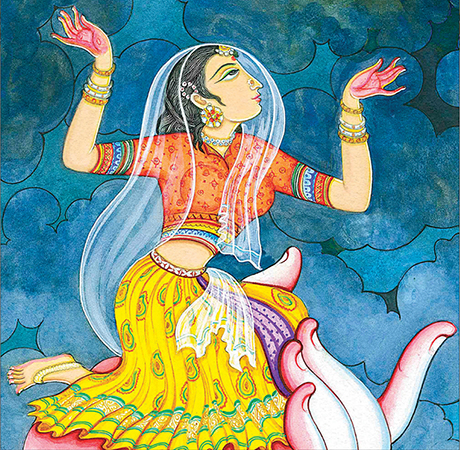
A. MANIVEL§
A devotee kneels in a state of blessedness, eyes lifted toward her Lord Śiva, who cradles her in the sheltering palm of His hand. In her state of centered and serene awareness she inwardly discerns His perfect universe and knows that nothing is wrong in this world. Her serenity has blossomed as she perfected yoga in all the four states.§
Sleep & Well-Being
 UR BIOLOGICAL TIME CYCLE THROUGH THE DAY IS NOT SIMply a physical movement but reflects an inner movement in consciousness. It is not defined by mere physiological energies but is ultimately connected to inner powers of eternity, from which we gain our capacity to renew body and mind.§
UR BIOLOGICAL TIME CYCLE THROUGH THE DAY IS NOT SIMply a physical movement but reflects an inner movement in consciousness. It is not defined by mere physiological energies but is ultimately connected to inner powers of eternity, from which we gain our capacity to renew body and mind.§
Our biological clock reflects the movement of the Sun outwardly, as we wake in the sunlight in the morning and go to sleep at night after the Sun has set. On an inner level, our biological clock is defined by prana and measured by the breath. Each day, according to yogic texts, we have around 21,600 breaths, or one every four seconds, with 360 breaths every 24 minutes or 1/60th of a day.§
The mind moves along with the breath and shares its rhythms and fluctuations. During sleep, the prana returns within, along with the mind, to a withdrawn state. Our biological clock is reset in deep sleep for another day.§
Of course, there is much in our modern behavior that has removed us from the organic time of nature, with our events in social time measured by mechanical clocks. Beginning with the appearance of electricity, we have inhabited the night and habitually stay up past sunset, countermanding our biological rhythms. Until we accept our biological rhythms, proper sleep will be denied to us, and with that denial our physiological and psychological functions will be disturbed.§
Our biological clock decrees that we live one day at a time, with each day providing a new potential for experience. Our body, mind and ego continue from day to day but undergo subtle changes. Our life is not a continual movement in time but is modulated or interrupted by the fluctuations of day and night.§
Our consciousness returns to an unmanifest state every night during deep sleep and then reemerges in the morning for another day, almost like a daily death and rebirth. We underestimate the importance of our daily withdrawal into subtle realms, overwhelmed by our obsession with physical existence. This causes us to presume there is a continuous existence of our physical personality, which is not the case. Deeper forces of consciousness and eternity impact us during our daily life cycles.§
So, too, our spiritual practice proceeds one day at a time, with each day offering new opportunities for growth, transformation and realization of the greater consciousness within and around us. Our spiritual life benefits as we learn to embrace the uniqueness and transforming power of each day.§
Mind & Prana§
Our mind and prana change radically in the four states. In the waking state, both mind and prana are active outwardly. The mind is caught up in dualistic currents of attraction and repulsion, like and dislike, pleasure and pain, love and hate. The prana is caught up in dualistic currents of inhalation and exhalation, sensation and action, and the movement of energy on the right and left sides of the body.§
In the dream state, the mind is withdrawn inwardly and our prana also turns within. Our inner mind comes forth with its luminous dreams and powers to radically alter our time-space experiences. We also experience a subtler non-physical prana that projects a changeable dream body according to the thoughts of the mind. While dreaming, we function in the astral body—consisting of the pranamaya, manomaya and vijnanamaya koshas. Pranamaya dreams are largely energetic and instinctual in nature. Manomaya dreams are sensory and emotional. Vijnanamaya dreams connect to deeper insight and cross over into deep-sleep type meditations.§
In deep sleep the mind merges into a state of latency. The body is upheld by prana, which sustains it from its seed state. (This is discussed in detail in the Prashna Upanishad.) We experience a natural deep pratyahara, sensory withdrawal, in which all our faculties return to their core energy.§
In the fourth state, turiya—for those who are able to experience it through meditation—prana and mind are merged within a deeper consciousness. The mind ceases to make any movements of its own, functioning only as an instrument of unitary consciousness, no longer able to generate false ego activity. To reach that fourth state, we must give up our identification with the body, and remove the knot of prana that connects us to it.§
It is said that in the waking state our consciousness dwells in the eyes, specifically the right eye. In the dream state it dwells in the throat. In deep sleep it dwells in the heart—meaning the deeper spiritual heart, not the physical or emotional heart. In the fourth state it is also centered in the heart but consciously, not unconsciously as it is in deep sleep.§
Healing§
Drawing our prana, or vital energy, within us is the essence of all deeper healing. In this regard, the prana of deep sleep has the special power to heal all the other pranas, as well as the mind. In deep sleep, the brain is able to remove negative patterns and energies and reset its equilibrium. This is vitally important in all psychological healing.§
Yet, the deepest healing of the body also comes from the awareness and prana behind deep sleep. A yogi can access this inner power of prana and direct it through his hands or through his eyes, using it to both guide and heal his disciples.§
Sleep and the Home§
Most of us define our homes as where we sleep, reflecting sleep’s importance. Our bedroom is the most intimate room in the house. We all look forward to going home and having a good night’s rest, particularly after a hectic day or after having traveled away for some time. Having no home or place to sleep of our own is a great trauma. Establishing our home or place of rest is the foundation of our sense of well-being. Sleeping in the same place affords us a certain inner contentment.§
Yet, it is not just a question of a house, room or physical home. Sleep takes us back to our spiritual home, the divine energy and consciousness through which deep sleep renews us. We all sense that benefic power. When we have difficulties in life, we all wish to return to the quiet and rest of our homes, in which we can shut the outer world off, be ourselves, relax and let go—and have a good sleep.§
We are all happy to go to sleep because we recognize that sleep brings us to a natural state of peace and well-being in which we can release the cares of the world. Beggar or king—sleep is the same for both. This peace of deep sleep can help us understand the peace inherent in our deeper consciousness. Yet, it is not enough to rest in our outer home, we must learn to rest in our inner home, which is the core awareness within our own hearts.§
Qualities of the States of Consciousness (Avastha)

The Great Cosmic Dream
 UR LIVES ARE BUT A LONG SLEEP AND DREAM, NOT OF A mere personal nature but of our soul, which has had many lives in many different bodies and worlds of experience. Our physical lives are based upon forgetting our eternal origin and falling into the allure of a transient external reality, in which we lose our true spiritual identity and come to think of ourselves as only the physical body.§
UR LIVES ARE BUT A LONG SLEEP AND DREAM, NOT OF A mere personal nature but of our soul, which has had many lives in many different bodies and worlds of experience. Our physical lives are based upon forgetting our eternal origin and falling into the allure of a transient external reality, in which we lose our true spiritual identity and come to think of ourselves as only the physical body.§
How long does our physical life continue unbroken? Most of us will reply as long as a lifetime. The fact is that our physical awareness is broken every day by the state of sleep. We spend around eight hours a day, or a third of our lives, in the sleep state. We know much less about the sleep state than we do about the waking state. We do not take sleep seriously or regard it as having any validity of its own except as an epiphenomenon of the waking state. Yet, there is much hidden within it, including the secret of what the waking state is based upon.§
The Fact of Impermanence§
What most characterizes a dream is that what happens in it is but a momentary affair, with no lasting result or continuity in the outer world. You cannot visit your dream locations in the waking state. Once a dream is over, it is quickly forgotten. We can experience great success or great difficulties in the dream state, but normally do not take them seriously once we awaken.§
Though the waking state is more enduring than dreaming, it has similar limitations in time. It also eventually comes to an end and must be forgotten. The waking state is a kind of prolonged collective shared dream. We experience a common waking world that appears fixed in nature, what we call the material world. But if we look deeply we see that physical reality is changing every second. Modern physics has deconstructed physical reality and shown it to be an illusion of subtle particles and energy fields in a vast interconnected universe of space and light. Behind the apparent stability of the material world are ongoing changes that reveal its illusory nature.§
The movement of the day shows its transient nature, with morning quickly turning into afternoon and evening. An hour can pass by so quickly that we fail to notice. The shift of the seasons through the year is the prime factor of change and transformation in the world of nature. The outer rush of prana in the springtime is followed by its inward withdrawal in the autumn. Most important is our own aging process through our biological clock, showing that our physical body is not a fixed reality but a limited movement in time. And our mind changes more quickly than the body, having ups and downs, even in the period of a few minutes or hours.§
The transience of our lives indicates their dream-like nature. In the end—however things may appear to last, however much we gain or lose—they come to an end, which is to end up as nothing, whether it is yesterday’s food, our own childhood experiences, or the achievements of our adult life. The tragedy of those individuals who die young is a reflection of life’s unpredictable transience. In fact, none of us can be guaranteed that this current day is not our last!§
Most of us have experienced this truth of impermanence in dramatic ways, going back to older family homes, for example, and finding that they have radically changed or that they are no more. We all lose our friends and family members in the course of time. Sometimes the world loses interest in us, particularly as we become older. Even if great world leaders pass away, in a few weeks they, too, are forgotten. The movement of time is relentless and leaves nothing standing in the end.§
The experience of impermanence is the basis of much great art and literature, particularly tragedies. We all are unhappy facing the fact that we ourselves will eventually die. But we fail to see that our longing for eternal existence reflects the deeper reality of our soul, which is not bound by time. To discover that immortal soul, we must move beyond the illusion of time that is created by our daily cycles of waking, dream and deep sleep.§
In the ignorance of deep sleep, we forget our cosmic reality and fall into a limited, outward-looking self-awareness. This is the stupor of the ego that causes us to take our physical body as our true nature and forget the wellsprings of consciousness within us. The obscuring power of deep sleep remains with us in the background through waking and dream.§
The Illusion of the Senses§
Our physical world is a reality or phantasmagoria put together by our physical senses. Our sense of sight provides us with our main image or idea of the world. Sound provides us with communication. Touch, taste and smell provide more physical sensations.§
Yet, the senses do not provide a perception of the true nature of things. Sensory images are suggestive and easily stimulate our imagination, which is a dream-like function, projecting fantasies of what we would like to happen or to achieve upon what our senses present to us. For example, the sight of a beautiful woman affects the male senses differently than the female. The smell of food to a hungry man is more powerful than to one who has just eaten. Provoked by our senses, biological imperatives compel us to act.§
We spend much of our time evaluating our chosen reality, whether it is what to buy, our relationships or who we are really. The development of intelligence requires learning to discriminate between how things appear and what they may actually be. Vedic thought tells us that the entire universe is but a reflection, like images in a mirror seen from a deeper consciousness.§
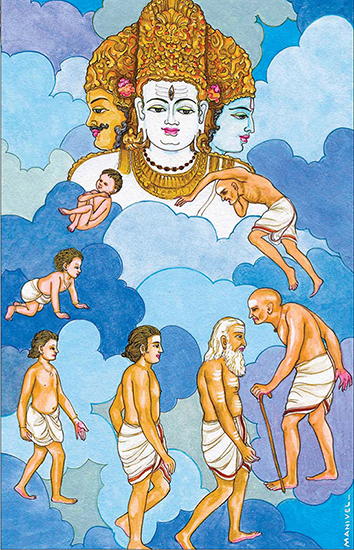
A. MANIVEL§
As Brahma, Ishvara creates. As Vishnu, He sustains. As Rudra, He draws all back to Himself. Here Ishvara, as Trimurti, guides the reincarnation process as a soul is embodied, grows to manhood, then declines into old age and death, to be reborn again to experience the world and evolve. The author submits that on another scale each day is a birth, an evolving and a death, and each morning we awaken in a fresh and different form.§
Indeed, our sensory perception is as much a type of dreaming as it is a seeing or cognition. Our senses are as much faculties of dream and desire as they are a means to objectively determine the nature of any enduring reality.§
We are all familiar with the famous story of five blind men, each coming to a different conclusion about the nature of an elephant, owing to their limited contact with it. Our five senses provide us information about the world that can obscure or confuse us as much as bring clarity. We must strive to understand who we truly are as conscious perceivers behind the five senses and the ephemeral physical body.§
In today’s information technology era, many people are living more in fantasy reality than in clear waking consciousness. We have invested our lives with virtual reality, social media images and digital bios that attempt to represent us to other people. Indeed the desire and fantasy nature of our physical reality is easy to see if we but examine our mental activity throughout the day.§
Each Life Is a Day in the Lifetime of Our Soul§
The daily movement from waking to dream and deep sleep reflects the longer movement of our souls from one life, or incarnation, to another. Waking relates to our sojourn in physical reality, the realm of dense matter and form. This relates to the Earth in yogic thought. Dream relates to our sojourn in astral reality, the realm of subtle form, thought and energy. This is sometimes called the atmospheric realm or realm of the Moon in yogic thought. Deep sleep relates to our sojourn in formless, causal realms of seed energy and light. This relates to Heaven, the realm of space or the Sun in yogic teachings (Prashna Upanishad).§
The experience of death and rebirth is much like sleep, dream and reawakening on a daily level. Death is but a sleep in which we have unembodied dreams and eventually awaken in a new physical incarnation. Each day we undergo a birth and death, as it were. The self that wakes up in the morning is slightly different than the self that went to sleep the night before. We leave something behind every night and take up something new every morning. Most forget this daily change of nature, but for those who are aware it is easy to see. Try to hold a certain thought right before you go to sleep at night and then remember it at the moment you wake up in the morning. It is not uncommon to forget what it was.§
Mastering the daily movement from waking to deep sleep helps us master our soul’s greater journey through the physical, astral and causal worlds. If we can live one day fully in consciousness, we can conquer death and transcend all time and space. The mysteries of day and night are profound.§
Every Day as the Creation of the Entire Universe§
Deep sleep state can be identified with Mula Prakriti, the root substance of the universe. If we can remain conscious and observe it, we can penetrate to the origin of creation. We can experience the creation of the universe every day, its unfoldment from pure consciousness to gross materiality, through the cosmic Aum vibration.§
Behind deep sleep is the consciousness of Ishvara, the Creator, Preserver and Transformer of all, with which our soul is one. We can experience every day how Ishvara creates and absorbs all. This Ishvara is the Adi Guru or original teacher of yoga through the cosmic vibration Aum, as is taught in the Yoga Sutras. Our individual soul mirrors this cosmic creative process within our mind.§
Actually, all of eternity is present at every moment in time. Each day and night reflects the movement of time overall as the day and night of Brahma, day being the cosmic creation and night its withdrawal, or pralaya. Eternity is the unending day of pure consciousness, whose dualistic shadows of day and night form our outer world of experience. Once we remove the ignorance from our minds, that will be our constant experience. Similarly, every point in space is the Infinite, overflowing with numerous Brahmandas, or cosmic eggs, unfolding various world systems.§

Yoga in Each of the Four States
 UR TRUE SELF IS NOT MERELY THE SELF OF THE WAKING state identified with the physical body. Our true Self is behind and beyond all the four states. Having deeply explored this mystery, Hinduism presents us a clear system for understanding and transcending the three limited levels of awareness and a practical means for attaining the fourth state, which brings a direct perception of eternal reality. It is important to be aware of all aspects of our self and consciousness in the states of waking, dream, deep sleep and beyond. For this purpose, we have outlined the yogas of the four states below; but these overlap to a great extent.§
UR TRUE SELF IS NOT MERELY THE SELF OF THE WAKING state identified with the physical body. Our true Self is behind and beyond all the four states. Having deeply explored this mystery, Hinduism presents us a clear system for understanding and transcending the three limited levels of awareness and a practical means for attaining the fourth state, which brings a direct perception of eternal reality. It is important to be aware of all aspects of our self and consciousness in the states of waking, dream, deep sleep and beyond. For this purpose, we have outlined the yogas of the four states below; but these overlap to a great extent.§
The Power of Consciousness§
Behind the daily movement of consciousness is a great power, the shakti of consciousness, which sets this process in motion. No one can stop the daily process of waking, dream and deep sleep. We can stay up later but must eventually succumb to this inner force.§
This shakti has secret powers of transformation that we can cultivate. It develops into the kundalini shakti, the inner power of consciousness that draws us to the highest awareness. The movement beyond deep sleep to pure consciousness rests upon the kundalini shakti and is part of its awakening, though this may not be specifically said in all the teachings about the four states. Kundalini shakti is the power of cosmic sound and is made up of the letters of the Sanskrit alphabet. It is the power that arises from the primal sound, Aum, which sustains all the vibratory forces of the universe.§
Yoga in the Waking State§
The yoga of wakefulness is striving to be conscious and attentive in all that we do. It is a cultivation of direct perception in which we distinguish our eternal essence of awareness from the outer forms limited in time and space. Most of us are half asleep during much of the day, falling into speculation, imagination, daydream, habit, enjoyment and loss of self-awareness, rarely connected and sustained by our inner consciousness. True wakefulness is being mindfully aware at every moment, observing the world with detachment, rather than running after it with desire. There is nothing the world can offer that can compare to the depth of awareness, perception and insight within us.§
We all have our moments of clarity and wakefulness in the waking state, lucid moments that allow us to make wise decisions. But few people consciously cultivate this state.§
It may sound odd, but we need to cultivate staying awake while awake, rather than drifting off into mechanical action or compulsive reaction, and getting lost in the dream of the material world. Our base emotions are largely subconscious reactions, rather than conscious responses. Fear, anger or desire are little better than dreams, unintelligent ways to interact with the world. If we examine our so-called waking state, we will find that there is little true wakefulness within it, but predominantly distracted or dull states of mind.§
The yoga of the waking state is one of moment-by-moment wakefulness. All its practices are merely supports for this. There are many ways to become more aware while awake. A yogic goal is to perfect these sadhanas and carry them on to the other states of consciousness.§
Chanting and meditating upon Aum is a helpful support practice to all the yogas of the four states. Chant Aum as you fall into sleep; chant Aum as you awaken in the morning. This helps us hold wakeful awareness throughout the day and carry it into dream and sleep as well.§
Remembering ourselves as the witness of the waking state—with dream, deep sleep and cosmic consciousness as the deeper aspect of our nature—is a key practice, not losing ourselves to the external world, but remaining composed within. Cultivating memory overall is a strengthening aid.§
Holding to a mantra throughout the day, such as Aum Namah Shivaya, helps remind us of our deeper awareness. Yet, we must energize the mantra with attention. Mere mechanical repetition can result in a loss of wakeful awareness. Most important is to remember the Deity through mantra the first thing each morning, such as with Hinduism’s many morning remembrance chants, pratar smarami.§
Brahma Muhurta, the period of one to two hours before sunrise, is the ideal time for meditation. It is the time of day when we can most easily connect with the forces of cosmic consciousness, drawing the awareness behind the deep sleep state into the waking state and experiencing how the entire universe arises from Brahman as Aum.§
Pranayama brings us back when our mind drifts into a lack of awareness, breathing in the deeper energy of consciousness that persists in deep sleep. The more we have such a unified and spiritualized prana, the more we can hold our awareness centered within throughout the day.§
By using the senses for contemplative awareness, rather than entertainment or enjoyment, we learn to be aware of the presence of Being and the light of consciousness behind the forms of nature. This sadhana can be developed further into pratyahara, or sense withdrawal.§
Cultivating a sense of the impermanence of all waking experiences, including dramatic events in our own life, helps us identify with our true Self.§
Karma yoga, selfless service, allows us to imbue our actions with awareness and let go of mechanical reactions. This is particularly important if we find meditation practices difficult. Those who remain perpetually awake never die, for their wakefulness is not rooted in the physical body but in recognition of the divine presence. To achieve this requires being undistracted and concentrated in all that we do. This cannot be achieved immediately, but we can make progress every day.§
Yoga in the Dream State§
At the moment we fall asleep we encounter a doorway in consciousness through which we can enter into the ever-wakeful state. This we should learn to recognize. We should prepare for the moment of sleep as an opportunity to transcend our waking self and its outer reality. Then, instead of simply falling asleep, we can move into a meditative state.§
To be able to move into this state of conscious sleep, it is helpful to shut down all media and electronic influences at least two hours before sleep. Go out into nature for a few minutes, chant or silently meditate, perform some rituals using ghee lamps or incense. Such practices will clear your mental field from the agitated patterns of the day. When you lie down to sleep, first voluntarily let go of the mind and hold to the inner light. Remind yourself that you are neither body nor mind, which are but your instruments.§
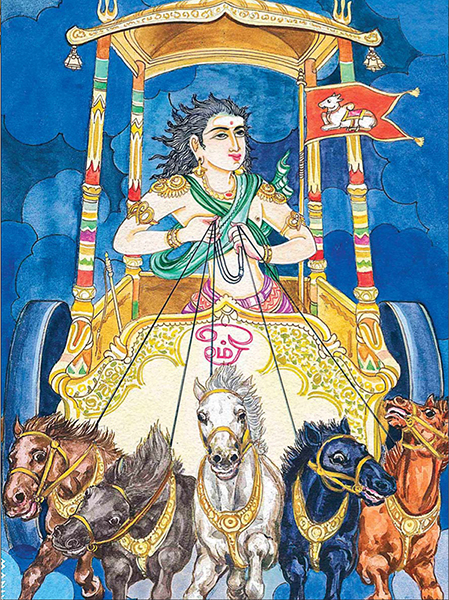
A. MANIVEL§
To control the mind in all states of consciousness, one must harness and discipline the senses and bring awareness into a state of uninterrupted concentration. Here a charioteer holds the reins of five horses which represent his five senses, firmly and positively guiding them toward his spiritual destination.§
You can also contact that doorway to the clear light of awareness at the times of sunrise, noon and sunset. The Gayatri mantra is used for that purpose, directing us not only to the light of the outer Sun but to the light of the inner Sun, the light of consciousness behind the dualities of the outer world.§
A mini-waking and sleep or birth and death happen with all the different movements of our nature. This includes the opening and closing or winking of the eyes, and each breath, with its inhalation and exhalation. Yogis know how to cultivate these points of transformation, as in the fixing of the gaze or in the holding of the breath. The waking and sleep cycle is the most important of these.§
In the dream state we have access to the subtle elements, or tanmatras, the creative essences behind the sensory potentials of sound, touch, sight, taste and smell. The sensory potentials of the dream state are actually much greater and more refined than those of the waking state, but require some cultivation of the mind and perception to access. The dream state provides access to worlds of subtle perception, imagination and creativity. These are great realms of art, vision, inspiration and joy. Cultivating higher sensibilities and artistic expressions can help us reach the higher levels of the dream state.§
Certain occultists pursue astral travel—waking and moving in the dream state and the astral world. They realize the reality of the dream state. While they may have various psychic abilities, they can still be caught in subtle ego, illusion and desire, which are considerable in the dream realm.§
There are various meditative approaches that teach us to manipulate our dreams in order to transcend the outer idea of who we are. Some yogis learn to awaken in the subtle or dream body and visit the subtle worlds for higher knowledge and experience, without being trapped in its illusions. Others seek to circumvent the dream state and go directly into formless levels of awareness beyond any imagination. Note that imagination, called vikalpa in Sanskrit, is the main mental fluctuation that yoga implores us to master.§
There are two aspects of the yoga of dreaming. The first is to try to become conscious in the dream state (which usually puts our dreams to an end). This does not mean being aware in our waking ego in the dream state, but holding to the witnessing consciousness, detached from body and mind, being aware that we are dreaming. This allows us to transform our dreams into tools of deeper insight, recognizing that dreaming is but a creation of our own mind.§
The second aspect of this yoga is to dream our highest spiritual dreams and aspirations, which is closely connected to bhakti yoga. It is to cultivate the higher powers of imagination, the visionary powers of the mind, to reflect a higher spiritual reality. Dream is the best state in which to dream our highest dream, which, if we go to the core of our hearts and the eternal wishes of our souls, is that of communion with the Deity in divine realms of pure energy, light and happiness. Bhakti yoga has a special resonance with the higher aspects of the dream state. Enjoying devotional music, mantra and chanting before sleep can transform the dream into a natural state of worship. Creative visualization is very helpful, particularly visualizing the Divine with our inner eye. Performing manasa puja, or mental puja, is excellent for spiritualizing the dream state. As you fall asleep, call to mind the image of the Deity and commune with it. You should pursue your highest dreams in life, which are to commune with the greater universe within our own hearts, worshiping the Divine in the form that your heart most aspires to.§
Yoga in Deep Sleep§
The yoga of deep sleep is primarily abiding in formless awareness, returning to the original void or state of emptiness in which everything is hidden in seed form. In deep sleep there is no objective world to be perceived, nor a separate self with which to perceive. World and self-consciousness are merged in a state of pure potential, with currents of possibilities and structures of underlying cosmic principles or dharmas. There is a mass of light, energy and vibration with only incipient movement. There is no outer or form-based bodily self. Being conscious of this root vibration is the yoga of deep sleep.§
The higher, formless worlds of the causal plane can be reached through developing awareness in deep sleep. These are realms of meditation, voidness and light. We can earn access to them by cultivating a deeper peace and contentment and by learning to be a formless being, a pure mind, without the need for an external world or body. We can do so by cultivating higher principles of unity and harmony, the rule of cosmic law. One way to facilitate this is to meditate on the yantras, or geometrical forms, of the Deities, like the famous Shri Yantra.§
The yoga of deep sleep happens on two levels. It begins in the waking state with the practice of deep pratyahara, or sensory concentration and withdrawal. In this way it is possible to draw the mind, prana and senses into a condition of wakeful deep sleep. One holds the awareness deep within the heart, and the outer mind and senses are shut off.§
Then, during deep sleep, one strives to maintain continual awareness throughout, not as the waking personality, but as the deeper awareness behind the mind. This is the true yoga nidra, or yogic sleep.§
Another important part of the yoga of deep sleep is cultivating peace and contentment in daily life, particularly the ability to surrender, relax and accept. Practicing pratyahara in the waking state aids in this. We must learn to let go of name and form, body and mind and rest in the undifferentiated state of awareness. We must accept the great mystery that true knowledge transcends the mind and that what the mind knows is just a form of darkness or ignorance that can at best merely reflect some aspect of the light. Then deep sleep can lead us into the turiya state.§
Yoga Nidra§
Yoga nidra is one of the most important aspects of traditional yoga practice. Its popularity today shows a new interest in the more esoteric yogic practices. Many forms of relaxation and pratyahara are now being taught as yoga nidra, but these are preliminary practices only. True yoga nidra is an integral part of the yoga of the four states, cultivating wakefulness during waking, dream and deep sleep. It involves moving into the inner peace of the witness Self at the time of sleep or rest. It allows us to consciously enter into deep sleep like a deep pratyahara, and gives us the ability to shut off the sense and motor organs during the waking state as needed. In this condition, we withdraw our consciousness into the heart—not the physical heart but the deeper spiritual heart. In the state of yoga nidra, in which the mind is suspended, one can contact the free flow of knowledge from the higher consciousness. This is described as dharma megha samadhi in the Yoga Sutras. Through true yoga nidra, we contact the consciousness of Ishvara, the inner teacher of yoga.§
Yoga in the Fourth State§
The underlying practice behind the yogas of waking, dream and deep sleep is cultivating the witness consciousness, or sakshi bhava. To remain firmly in the witness state is to immediately cross over waking and sleep, time and space, birth and death. This begins with cultivating wakeful awareness, conscious dreaming and remaining aware in deep sleep.§
Cultivating the witness state is also the core practice for the fourth state, but requires support practices. First, we should maintain a dharmic and conscious lifestyle, such as outlined in the yamas and niyamas of yoga practice. This includes a vegetarian diet, control of our sense and motor organs, and control of our mind and emotions. All of this is required for any serious meditation practice. Second, we must learn to sustain a moment-by-moment awareness. This begins by regular meditation practices morning and evening, mantra and certain spiritual qualities, particularly astute powers of attention, concentration and detached observation.§
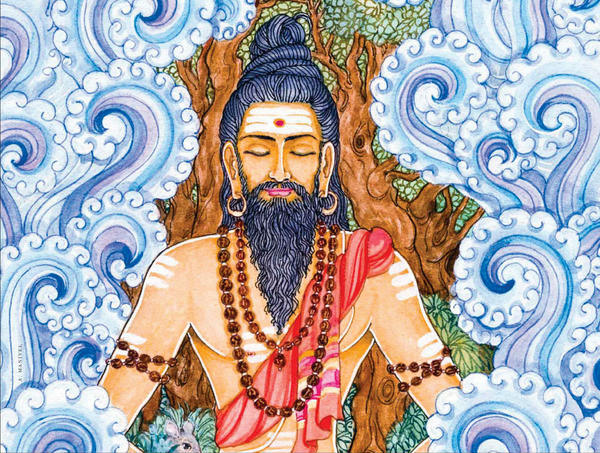
A seasoned meditator is immersed in his deepest Self, while outer pranas and thoughts flow around him. He has controlled karmas sufficiently to master the art of nonreaction and withdraw into samadhi. With such adeptness, he can readily reach the subtle worlds of the causal plane in deep sleep.§
Natural Patterns of Sleep
From: healthysleep.med.harvard.edu§
OUR BODIES REQUIRE SLEEP IN ORDER TO MAINTAIN PROPER function and health. In fact, we are programmed to sleep each night as a means of restoring our bodies and minds. Two interacting systems—the internal biological clock and the sleep-wake homeostat—largely determine the timing of our transitions from wakefulness to sleep and vice versa. These two factors also explain why, under normal conditions, we typically stay awake during the day and sleep at night. But what exactly happens when we drift off to sleep? Prior to the era of modern sleep research in the early 1920s, scientists regarded sleep as an inactive brain state. It was generally accepted that as night fell and sensory inputs from the environment diminished, so too did brain function. In essence, scientists thought that the brain simply shut down during sleep, only to restart again when morning came.§
In 1929, an invention that enabled scientists to record brain activity challenged this way of thinking. From recordings known as electroencephalograms (EEGs), researchers could see that sleep was a dynamic behavior, one in which the brain was highly active at times, and not turned off at all. Over time, sleep studies using EEGs and other instruments that measured eye movements and muscle activity would reveal two main types of sleep. These were defined by characteristic electrical patterns in a sleeping person’s brain, as well as the presence or absence of eye movements.§
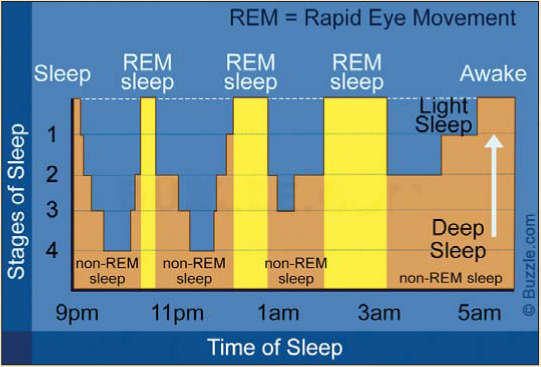
BUZZLE.COM§
The two main types of sleep are rapid-eye-movement (REM) sleep and non-rapid-eye-movement (NREM) sleep. On an EEG, REM sleep, often called “active sleep,” is identifiable by its characteristic low-amplitude (small), high-frequency (fast) waves and alpha rhythm, as well as the eye movements for which it is named. Many sleep experts think that these eye movements are in some way related to dreams. Typically, when people are awakened from REM sleep, they report that they had been dreaming, often extremely vivid and sometimes bizarre dreams. In contrast, people report dreaming far less frequently when awakened from NREM sleep. Interestingly, during REM sleep muscles in the arms and legs are temporarily paralyzed. This is thought to be a neurological barrier that prevents us from “acting out” our dreams.§
NREM sleep can be broken down into three distinct stages: N1, N2, and N3. In the progression from stage N1 to N3, brain waves become slower and more synchronized, and the eyes remain still. In stage N3, the deepest stage of NREM, EEGs reveal high-amplitude (large), low-frequency (slow) waves and spindles. This stage is referred to as “deep” or “slow-wave” sleep.§
Cycling at Night§
In healthy adults, sleep typically begins with NREM sleep. The pattern of clear rhythmic alpha activity associated with wakefulness gives way to N1, the first stage of sleep, which is defined by a low-voltage, mixed-frequency pattern. The transition from wakefulness to N1 occurs seconds to minutes after the start of the slow eye movements seen when a person first begins to nod off. This first period of N1 typically lasts just one to seven minutes. The second stage, or N2, which is signaled by sleep spindles and/or K complexes in the EEG recording, comes next and generally lasts 10 to 25 minutes. As N2 sleep progresses, there is a gradual appearance of the high-voltage, slow-wave activity characteristic of N3, the third stage of NREM sleep. This stage, which generally lasts 20 to 40 minutes, is referred to as “slow-wave,” “delta,” or “deep” sleep. As NREM sleep progresses, the brain becomes less responsive to external stimuli, and it becomes increasingly difficult to awaken an individual from sleep.§
Following the N3 stage of sleep, a series of body movements usually signals an “ascent” to lighter NREM sleep stages. Typically, a 5- to 10-minute period of N2 precedes the initial REM sleep episode. REM sleep comprises about 20 to 25 percent of total sleep in typical healthy adults.§
NREM sleep and REM sleep continue to alternate through the night in a cyclical fashion. Most slow-wave NREM sleep occurs in the first part of the night; REM sleep episodes, the first of which may last only one to five minutes, generally become longer through the night. During a typical night, N3 sleep occupies less time in the second cycle than the first and may disappear altogether from later cycles. The average length of the first NREM-REM sleep cycle is between 70 and 100 minutes; the average length of the second and later cycles is about 90 to 120 minutes. The reason for such a specific cycling pattern of NREM and REM sleep across the night is unknown. Some scientists speculate that specific sequences of NREM and REM sleep optimize both physical and mental recuperation as well as some aspects of memory consolidation that occur during sleep, but this has not been confirmed.§
This leads us to the practice of Self-inquiry, tracing the I-thought to its origins in the heart. One asks the question “Who am I?” and follows its examination deep within the heart and inner consciousness. One inquires into the nature of the pure “I am” beyond the identified or objectified self of the waking state or bodily self. One then looks into the nature of the pure “I am,” beyond the self of the dream state, which holds our desires and wishes. Finally, one looks into the pure “I am” beyond the self of deep sleep, confronting the ignorance behind our lives and recognizing our true identity as pure consciousness.§
The true Self we are seeking is not the self of the waking state, but the Self behind waking, dream and deep sleep. Normally we seek realization for our physical, wakeful self, which is but a dream and an illusion. True spiritual practice begins when we set the waking self and outer waking world aside as unreal and learn to look within, removing the deeper veils of consciousness.§
Energizing the entire Aum vibration is a great aid in this process. Aum is the bow, our Self-awareness is the arrow, and Brahman or the transcendent state, is the target or goal, as the Mundaka Upanishad says.§
Another method is total surrender to the Deity, known as Ishvara pranidhana in the Yoga Sutras, and as prapatti in later devotional thought. This can be aided by mantra or practiced purely as the highest attitude of devotion.§
Other People§
Just as we ordinarily look at ourselves according to the waking reality only, we do the same with others, regarding them mainly in terms of their waking reality, which is when we actively are engaged with them. We should remember that each person and each creature undergoes these four states each day, just as we do. When you look at others, try to remember that they are also more than their waking selves. They also merge back into deep sleep and the primordial reality every day. While we are physically separate, we are all one in the state of deep sleep. When we reach the fourth state, turiya, we become one with all, and go beyond all bodily limitation and separations in consciousness.§
Dreams & the Astral World
From the teachings of Satguru Sivaya Subramuniyaswami§
 N THE INNER WORLDS, INNER UNIVERSE, THERE IS A LIFE NOT unlike this one that we experience as a jiva, but far more complete, intricate, logical and much more advanced. Within this world, the Antarloka, there are great schools where students gather to learn of a more productive future that they can participate in creating when they incarnate. Here they mix and mingle with other souls whose physical bodies are sleeping and whom they will work and cooperate with during their next cycle of birth. It is a well-planned-out universe, both the outer universe and the inner universe.§
N THE INNER WORLDS, INNER UNIVERSE, THERE IS A LIFE NOT unlike this one that we experience as a jiva, but far more complete, intricate, logical and much more advanced. Within this world, the Antarloka, there are great schools where students gather to learn of a more productive future that they can participate in creating when they incarnate. Here they mix and mingle with other souls whose physical bodies are sleeping and whom they will work and cooperate with during their next cycle of birth. It is a well-planned-out universe, both the outer universe and the inner universe.§
The value of sleep for the person on the path is to gain the ability to bypass the lower dream state and soar deeper within to these inner-plane schools. This is done by the repetition of mantras, japa yoga, just before sleep, after relaxing the body through hatha yoga and diaphragmatic breathing.§
When japa is well performed and the sincere desire is maintained to transcend the forces of the physical body and enter into the astral schools of learning, the aspirant would have dreamless nights. A deep sleep would prevail. There may be a few seconds of dreaming just before awakening, to which one should not pay any attention, as the astral body quickly reenters the physical. But a deep, dreamless sleep is in itself an indicator that the purusha is totally detached from the physical forces and totally intact and functioning in the Devaloka.§
SHOULD DREAMS BE REMEMBERED? It is almost traditional in many cultures to try to remember one’s dreams, and dreamologists will even interpret them for you. This all borders close to the realm of superstition and is far less desirable for spiritual growth than other more pragmatic types of practices. A beginner on the path, or even one in the intermediate phase, should endeavor to forget dreams and strengthen the fibers of the mind and psyche through daily sadhana. There is actually a time, on the yoga marga, after the charya and kriya margas have been well mastered and passed through, that the remembrance of one’s dreams is beneficial and fruitful, but this would only be between the guru and the shishya.§
It may be beneficial for those under the guidance of a satguru to write them down each morning upon arising and put them at his holy feet at the end of each month. This would be strictly a guru-shishya training relationship and for a specified period of time, not more than four months. It might be scary, even disheartening, for you to do this for yourself. And satgurus would recommend that you forget your dreams upon awakening, for if remembered they may bring that reality into the awakened reality and produce experiences you would not want to experience.§
We want to forget bad dreams as quickly as possible, lest by remembering them through the conscious mind we impress them in the immediate subconscious and make them manifest in daily life. To think about a bad dream is to create. To forget it is to avoid creating. Therefore, if you have the slightest worry about dreams and are not directly under a guru’s guidance on a daily basis, it is best to let them slide by and consider them unimportant and not a part of you, as you would consider a television program to be.§
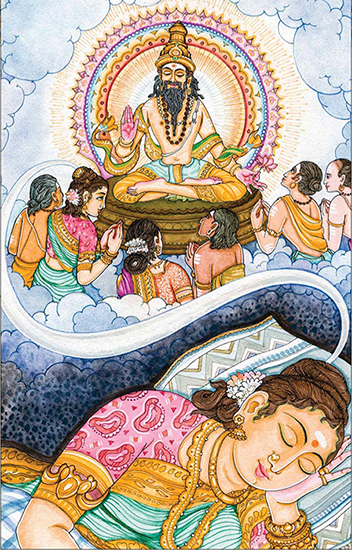
A. MANIVEL§
A seeker has consciously put herself to sleep after performing japa and meditating. This preparation has given her access to an inner-plane school where she meets with others in her astral body. Having learned how to join her satguru in these second-world classes, she avoids lower, energy-depleting dream states.§
Science & the Mind
By Vamadeva Shastri§
OVER THOUSANDS OF YEARS, INDIA’S CIVILIZATION HAS MADE the inner science of consciousness its main concern. Dharmic civilization recognizes that inquiry into the nature of consciousness is the most important way of knowledge and the most fundamental pursuit in life. This inner science is the supreme science, because through it alone can we truly understand the nature of the universe, its origin and goal, and also the nature of our own inner being, which is one with all.§
Modern science, with its many new research projects, is slowly developing a new view of consciousness that is better aligned with Dharmic traditions than the old, fixed, material view of the world. It is approaching consciousness in two ways.§
First, quantum physics is proposing a unitary field of consciousness behind the universe in order to explain the coherence of the laws of nature. So far, this universal field of consciousness is but a theory. Yet, it is well known in Vedic thought as Brahman, the pure consciousness behind the universe, the Vedic idea of God, the Divine, or the Supreme Reality, the origin and end of all.§
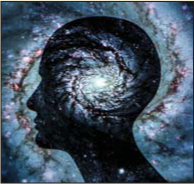
The second scientific approach to consciousness is through modern neuroscience, which includes the mapping of the brain, its functions and energies, and exploring how these affect our minds and our cognition, including sleep and dream. This new form of brain study is discovering the healing powers of yoga and meditation for mental health and neurological functioning.§
Still, modern science remains far from embracing consciousness as the Supreme Reality. The problem is that neuroscience identifies brain as the origin of mind and consciousness, which limits consciousness to the body, to physical reality. From this perspective, chemical medicine remains the main method for treating mental dysfunctions.§
Hindu thought teaches us that brain, mind and consciousness are related but different in nature. The physical brain is an instrument for the mind, but the mind has a level of existence extending beyond physical reality. The core mind, our karmic patterns, will leave the body at death and go on to another body and another life–as many yogis, mystics and occultists are well aware.§
Yet the mind, which has its own structure and functions and is part of nature, is not supreme either. It is an instrument for a deeper consciousness, our true Self beyond body and mind, which is the real source of awareness and is beyond all change and action, time and space. The atman is one with Brahman as the universal consciousness. The universal consciousness and embodied consciousness or mind are inseparably linked.§
Behind the physical brain and its chemistry is what could be metaphorically called a subtle brain of energy and awareness, the thousand-petal lotus, the highest of the seven chakras of yogic thought. It holds the secrets of higher consciousness, but must be activated by yogic practices. It is largely dormant or unevolved in the ordinary person.§
When modern science explores the brain for understanding consciousness, it is like measuring a man by examining the movements of his shadow. Hindu thought teaches us first how to transcend the brain along with its biological limitations and compulsions, then how to transcend the mind, which is individualized consciousness, to move beyond our karmic limitations. This leads us to eventually understand pure consciousness, which is an all-pervasive universal principle. This requires going to the core of our awareness that persists behind waking, dream and deep sleep.§

Scriptural Basis, the Mandukya Upanishad
 HE MANDUKYA UPANISHAD PROVIDES THE CLEAREST SCRIPTURAL SUPPORT for the yoga of the four states, though we find it commonly taught in many places in Vedic and yogic texts. The Mandukya Karika of Shankaracharya explains the four states in great detail. In it Shankara comments both on the Mandukya Upanishad and on the commentary of his paramaguru, Gaudapada. It is one of the greatest works of Advaita Vedanta.§
HE MANDUKYA UPANISHAD PROVIDES THE CLEAREST SCRIPTURAL SUPPORT for the yoga of the four states, though we find it commonly taught in many places in Vedic and yogic texts. The Mandukya Karika of Shankaracharya explains the four states in great detail. In it Shankara comments both on the Mandukya Upanishad and on the commentary of his paramaguru, Gaudapada. It is one of the greatest works of Advaita Vedanta.§
Section I§
1. Aum. The imperishable syllable Aum is everything. Now follows its explanation. What has been, what is and what will be, everything, is only Aum. And what is beyond these three periods of time, that is also only Aum. Everything is Brahman. The Self (atman) is Brahman. This Self has four quarters.§
Section II§
1. Dwelling in the waking state, with external knowledge, with seven limbs and nineteen mouths, the enjoyer of what is gross, that is Vaishvanara, the universal person, the first quarter of Aum.§
2. Dwelling in the dream state, with inner knowledge, with seven limbs and nineteen mouths, the enjoyer of what is subtle, that is Taijasa, the luminous, the second quarter of Aum.§
3. When sleeping, one has no desires and sees no dream, that is deep sleep, sushupti. In the state of deep sleep, one’s awareness becomes unified, a mass of knowledge. This is the state of happiness, with the enjoyer of happiness through the single mouth of consciousness. This is Prajna, the power of wisdom, the third quarter of Aum.§
4. This deep sleep state is the lord of all, the knower of all, the inner controller, the basis of all, the origin and end of all beings.§
5. Where there is no inner knowledge, no outer knowledge, no inner and outer knowledge combined, no mass of knowledge, no presence of knowledge and no absence of knowledge; what is unseen, beyond all appearances, without mark, unthinkable, what cannot be taught, which is the essence of the perception of the unitary Self, beyond the manifest world, auspicious and non-dual, that, the sages say, is the fourth quarter of Aum. That is the Self. That is to be known.§
Section III§
1. One should know this Self as the imperishable syllable Aum, by syllable, quarter and measure—A-kara, U-kara, M-kara—the letters A, U and M.§
2. The waking state and Vaishvanara is the letter A, the first quarter, the first measure. As the origin, it pervades all. One gains all desires and becomes foremost who knows this.§
3. The state of dream and Taijasa is the letter U, the second measure. Being elevated and holding both the other states, dream and deep sleep, one gains the continuity of knowledge and equanimity. No non-knower of Brahman is born in his family who knows this.§
4. The state of deep sleep and Prajna, the letter M, the third measure, is the measure in which all things dissolve. One measures and dissolves the entire universe who knows this.§
5. The measureless fourth state, turiya, beyond experience, the cessation of the phenomenal world, auspicious and non-dual, that is Aum; that is the Self. He enters by the Self into the Self who knows this!§
Commentary§
Aum is the entire universe, all time and what is beyond time. That Aum is our essential nature through the four states of waking, dream, deep sleep and turiya, which are its four quarters. From it all time arises, starting with the movement of our lives. These are the four aspects of our nature, symbolized by Agni as the flame of life and awareness.§
Vaishvanara stands for the digestive fire as the root energy of the waking state, the individual soul in the waking state. His seven limbs are the seven subtle energies of prana. The nineteen mouths are the five sense organs, the five motor organs, the five tanmantras (sound, sight, touch, taste and smell), and the four aspects of the mind (ahamkara, ego; manas, mind; buddhi, intelligence; and chitta, subconscious mind and memory).§
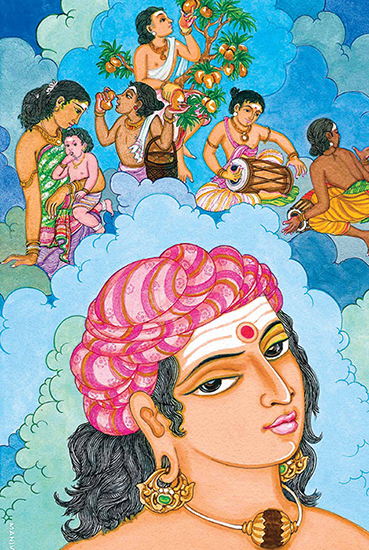
A. MANIVEL§
The dream state often involves ruminations in the subconscious mind, reliving events of the past, reveling in good times and anguishing over events that trouble the mind. Here a man dreams of happy moments with his mother, a summer day when he and a friend found a mango tree full of ripe fruits and his years of work learning the drum§
Taijasa stands for the fire of the mind. It reflects memory and the subtle essence of our waking experience that also connects us to the subtle worlds. This subtle body has the same form and faculties as the physical body but is composed of energy rather than matter.§
Prajna is the inner flame of wisdom at the core of our being behind deep sleep. All happiness in life derives from our ability to access the bliss or ananda that is filtered to us through the restfulness of deep sleep.§
The true Self is not an outer object that can be known through the mind. It is the unmanifest witness of all appearances. It is beyond the three states, waking, dream and deep sleep, and can only be known through moving beyond these three states and their faculties.§
The four states are the four aspects of Aum as A, U, M, and the silence beyond. Aum is the vibration of cosmic consciousness, the very sound of the Self. Wakefulness is the first state and holds the main experience of our consciousness. The dream state partakes of both waking and deep sleep, which are all part of a greater dream. The deep sleep state absorbs all. Behind these fluctuating conditions is the transcendent fourth, the state of pure unity. One should know that the same Self and flame of awareness is within and behind them all.§
Conclusion
Learn to transform your daily activity into a daily adventure in consciousness. Observe the changes of waking, dream and deep sleep with profound attention, as containing many secret doors to higher awareness. Cultivate a moment-by-moment awareness, so that you are always alert. Remember your eternal pilgrimage in consciousness, with each day as a stage in its cosmic unfoldment. Be aware of your daily movements from waking to dream and deep sleep and study how they affect body, prana and mind. Be awake within your eternally wakeful Self. Remember that to fall asleep in consciousness or to lose our awareness is a great calamity. Value every day as the ultimate day, the eternal day of the Divine Life. Try to bring out your eternal potential every day in a new way. Attune yourself to the power of consciousness that moves you through the three states. Let it take you beyond them as well. Your consciousness is the inner guide of the drama and destiny of your life.§
ABOUT THE AUTHOR
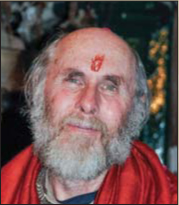 Pandit Vamadeva Shastri (Dr. David Frawley) is the author of over thirty books on Vedic subjects. He has a Jyotish Medha Prabha from the Indian Council of Vedic Astrology, a D. Litt. from SVYASA, and a prestigious 2015 Padma Bhushan award from the Government of India. Vamadeva is an advisor for the Council of Vedic Astrology (CVA) and director of the American Institute of Vedic Studies. He is a disciple of Sri Sadguru Sivananda Murty, was closely connected with Dr. B.V. Raman and is an associate of Chakrapani D. Ullal.§
Pandit Vamadeva Shastri (Dr. David Frawley) is the author of over thirty books on Vedic subjects. He has a Jyotish Medha Prabha from the Indian Council of Vedic Astrology, a D. Litt. from SVYASA, and a prestigious 2015 Padma Bhushan award from the Government of India. Vamadeva is an advisor for the Council of Vedic Astrology (CVA) and director of the American Institute of Vedic Studies. He is a disciple of Sri Sadguru Sivananda Murty, was closely connected with Dr. B.V. Raman and is an associate of Chakrapani D. Ullal.§


